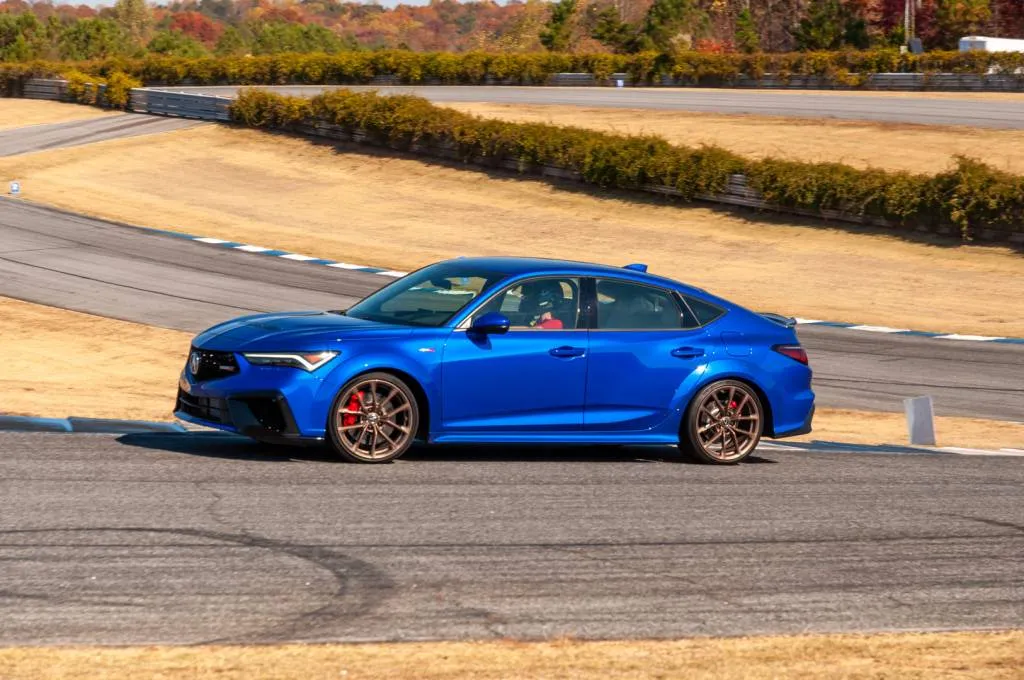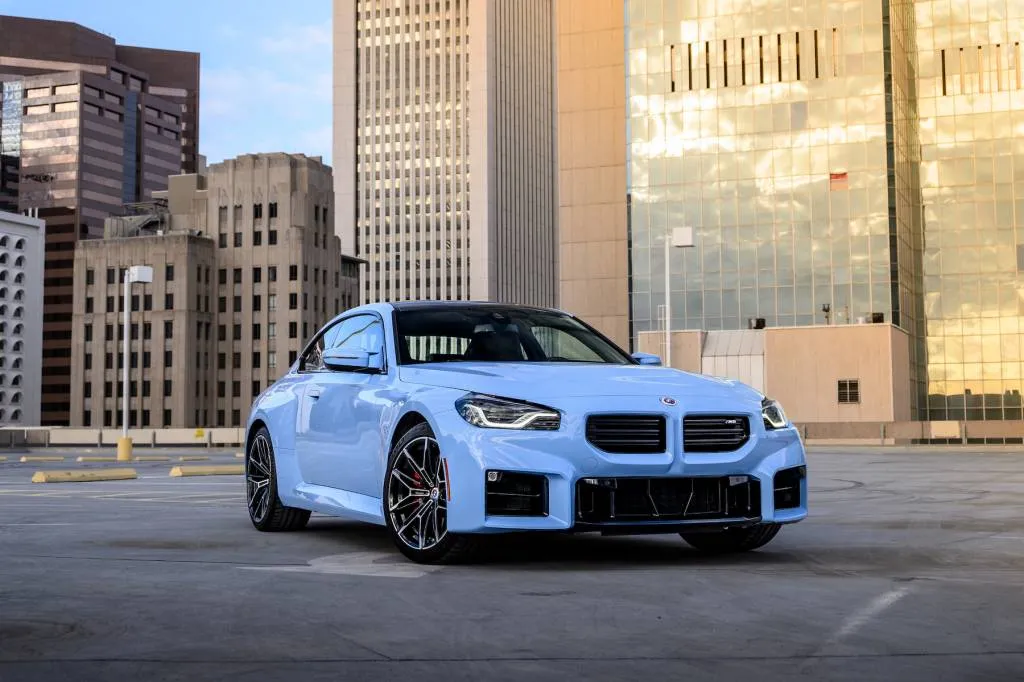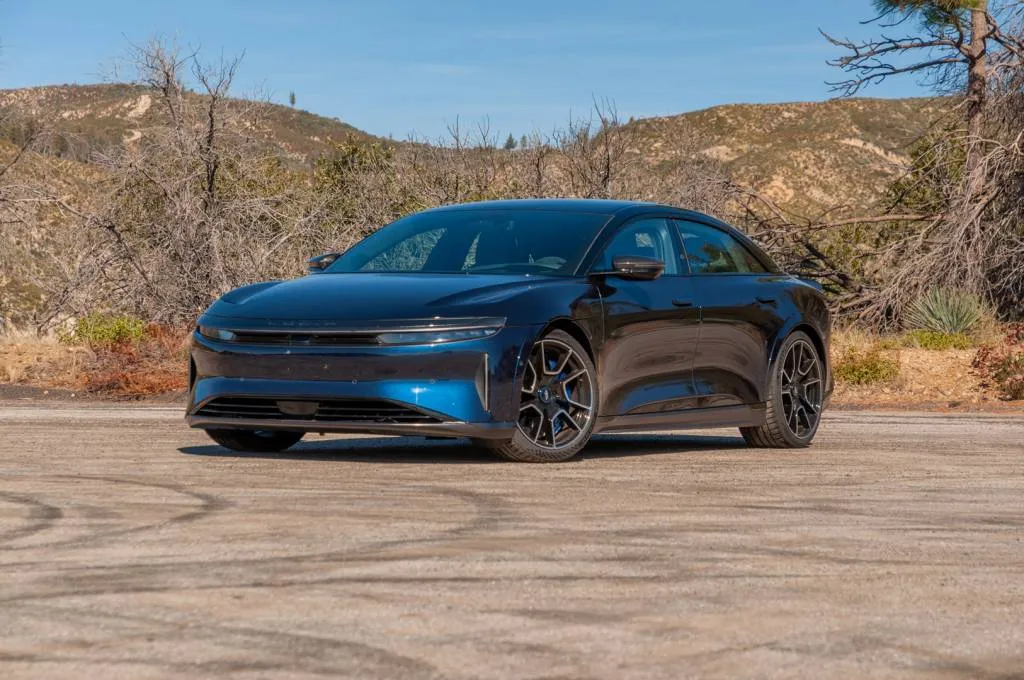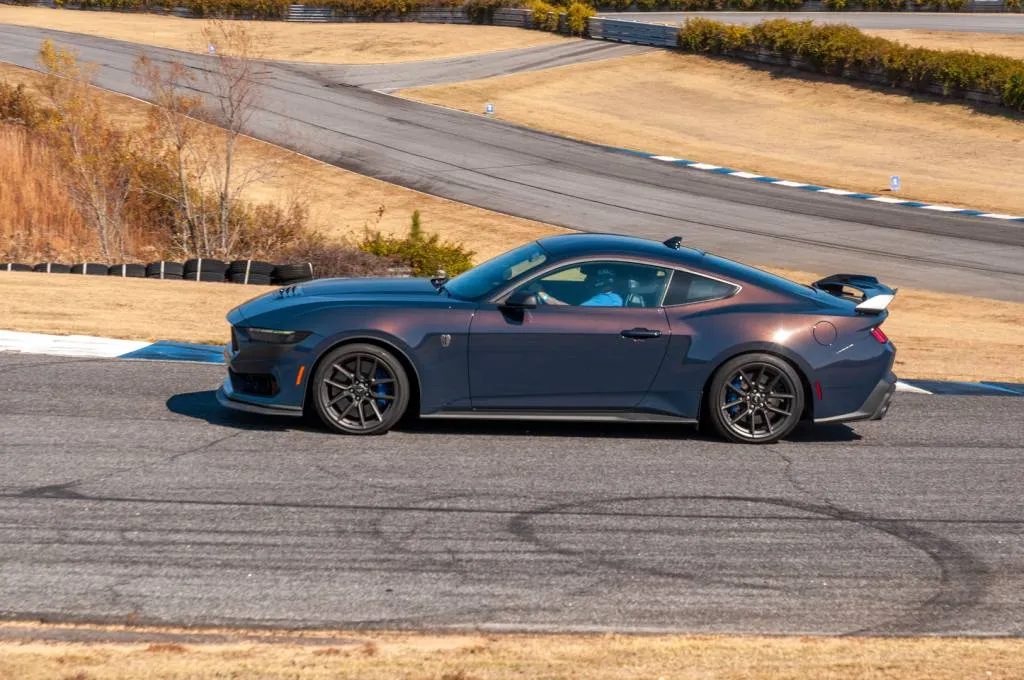We had this happen once before. During track testing for Motor Authority Best Car to Buy 2024, one car was so head-and-shoulders above the others that the winner of the award became obvious. The last time was 2019 when the Porsche 911 Carrera 4S buried the competition. This time it was the Chevrolet Corvette Z06. What a machine!
Scheduling conflicts meant that only three of our five finalists for the MA BCTB 2024 award could make it to the track. The track cars were the Z06, the Ford Mustang Dark Horse, and the Acura Integra Type S. Left on the sidelines were the BMW M2 and Lucid Air Sapphire.
But track testing isn’t the only consideration for the Best Car To Buy award. Value, price (those two things can indeed be separate), on-road livability, and overall fun factor also play into the mix. And when those criteria were considered, the Acura Integra Type S made a strong showing, but came up just short.
The following is a breakdown of what we learned about our finalists by driving them on the track at Atlanta Motorsports Park, comparing them head-to-head, and in individual loans and other track time for the cars that couldn’t make it to our testing program.

Chevrolet Corvette Z06
Winner: Chevrolet Corvette Z06
The Z06 shows how special the C8 Corvette can be. It not only has an exotic mid-engine design, but it also boasts a special flat-plane crank, 8,600-rpm screamer of an engine. It launches the car from 0-60 mph in a scant 2.6 seconds and its high-pitched howl tickled our eardrums while doing it. “The biggest issue with the C8 is you can tell the chassis is designed for more power. This engine fixes that issue,” said Senior Producer Joel Feder.
Senior Editor Bengt Halvorson noted that the engine doesn’t have a lot of immediate torque and you need to keep the revs up to get the most out of it. That’s easy because the V-8 is teamed with a telepathic 8-speed dual-clutch transmission that shoots the car forward with each stab of the throttle and crisp gear change.
The ’Vette’s low-slung stance, right-now steering response, flat cornering attitude, and accessible performance gave our staff confidence and had us shaking our heads in amazement after each stint. “With each lap I pushed harder. Go faster, you can do more. And I didn’t come close to the max of what it could do,” said Senior Editor Robert Duffer.
While we didn’t record lap times, it's no surprise the Corvette put up the fastest figures at a couple of key points on the track: 123 mph at the end of the front straight, and 81 mph at the apex of the carousel made up by turns 13, 14, and 15.
There was more room to grow for both figures, too, especially for the top speed at the end of the straight. Pinning the throttle through 16 would have likely added 10 mph by the end of the straight, but that would create a hard weight shift in the turn 16 transition onto the straight that can sometimes create a disconcerting slide. We avoided going that hard in that spot and that cost some top speed.
We liked the Z06 on the road, too. “Tour mode dials up a really nice ride. I was shocked at how good the ride was,” noted Halvorson. That’s great for the Z06’s everyday driver credentials, given it’s the Corvette with the firmest tuning.
Our lone complaint involved the brakes, and the gripe was mostly mine. Every Corvette has a brake-by-wire system that simulates feel. While our Z06 had the optional carbon-ceramic brakes with more than enough stopping power for multiple days of track time, it lacked initial feel and required getting used to the bite point of the pedal travel. On at least two occasions, I braked too late for turn 2, the first of two ess corners because the pedal felt wooden on initial application. The problem was probably exacerbated by coming out of the Mustang Dark Horse, which has a higher pedal and more initial bite. However, each time, I quickly got used to the Corvette’s brakes and had no more issues for the rest of each session.

Acura Integra Type S
2nd: Acura Integra Type S
We suspected that the Integra Type S would have the track capability of the Honda Civic Type R that won last year’s award, but Acura was promoting it as a more mature street car than the Honda. There was no track component to the media drive, either, but the Type S has all of the performance equipment of the Type R, minus the Recaro bucket seats. We worried that it might not have the cooling for track duty, but aside from brake smoke after its first track session, the Type S held up well. Not only that, but it did better than expected.
The Type S had a big disadvantage against the Mustang in performance equipment, but it performed almost as well. Its 2.0-liter turbo-4 makes 320 hp. It’s a torque-rich engine that needs to stay over 2,200 rpm for best power, but that’s no issue on a racetrack, where power is ready upon corner exit and pulls well on the straights. Best of all, the power is accessed through a lovely 6-speed manual transmission with short, positive throws and an easy-to-modulate clutch. Despite a 180-hp deficit, the Type S was only 4 mph slower at the end of the front straight than the Mustang.
Poise was the Type S strength that allowed it to challenge the Mustang. “Everyone who got into the Integra, within one lap you were confident and at ease with it,” said Editorial Director Marty Padgett. It tackled corners with confidence, taking a nice set and staying balanced despite the fact that the front wheels had to both turn and power the car on corner exit—a traction balancing act that feels natural in the Type S.
An example of that poise came in the apex of turn 15, where I was able to carry the same 77 mph as the Mustang, despite the Mustang’s stickier tires. Good suspension tuning and carrying about 700 fewer pounds will do that. Sport+ mode was needed to loosen the stability control for the turn 16 transition to the front straight. Sport mode clamped down on the power at that point likely due to a short loss of traction, but Sport+ mode let it loose and enabled more speed at the end of the straight.
The Type S is an easy commuter car on the road, with an agreeable ride and tame power—but also one that thrills you unexpectedly on a track. “For everything that car can do off of a track, for it to perform like that on a track was remarkable,” said Duffer.
As for those brakes, we worried we’d have to go easy on the Type S after Feder got them smoking in his first session. Well, we didn’t and they didn’t fade through three hours of track driving. With 13.8-inch front rotors and 4-piston Brembo calipers up front and 12.0-inch rear rotors with single-slot calipers, they’re not all that big, but they’re effective. Still, I’d want track pads and high-temp brake fluid for longer track days.
In the end, the Type S made a strong case for itself, especially given its fairly reasonable pricing of about $52,000. However, the performance gap between it and the Z06 was just too much to overcome.

2024 BMW M2
3rd: BMW M2
Timing prevented the M2 from making it to our track day, as BMW was having a large media testing program the same week and needed all the available M2s for that event. Too bad, as it would have likely represented itself well at Atlanta Motorsports Park. However, three of our editors got to drive it earlier in the year at Road America, both on the big track and a gokart track that doubles as an autocross course. A fourth whipped it around the Tail of the Dragon for good measure.
The M2 follows the recent formula for new M cars: It’s bigger, heavier, firmer, and faster around a track. By the numbers it’s better, but it’s lost a little something from the last-generation car that won the Motor Authority Best Car To Buy 2017 award. That car felt like an old-school BMW while the other M models were already employing the bigger-and-more-powerful strategy. It was lighter and tuned a little softer, with some well controlled body lean that provided feel in corners.
BMW packs 3.0 liters of wonderful turbocharged inline-6 under the hood of the M2. It spins out 453 hp, up 88 horses from the 2017 model. The power can flow to the rear wheels through a slick-shifting 6-speed manual transmission that’s not quite as tight as the Honda manual, or a very responsive 8-speed automatic.
Man, that power is ready, willing, and able. The 0-60 mph times are 4.1 seconds with the manual, and 3.9 seconds with the automatic. The M2 launches hard, builds speed quickly, and accelerates with gusto out of turns. “The M2 was fast as snot around Road America,” exclaimed Feder.
But at more than 3,800 pounds, it’s almost 400 pounds heavier than the 2017 model. BMW counteracts that with firmer suspension tuning that does its best to tame the weight. Compared to several much lighter vehicles on the autocross, the M2 required a stronger stab of the brakes to arrest the speed for corners, and it needed to be wrangled through them rather than taking a quick set and carving a precise line.
The fact that the M2 was able to not only compete in an autocross but beat most of the other lighter cars was a testament to adept suspension tuning. It manages to remain approachable. “Like the Integra, you get into the M2 and you immediately understand what that car is capable of and you can use 90% of it almost right away,” said Padgett.
It has more power and quicker track times, but we prefer the lighter, more friendly everyday nature of the M2’s successor, and without back-to-back track time the Z06 simply made a greater impression.

Lucid Air Sapphire
4th: Lucid Air Sapphire
Logistics also prevented the Lucid Air Sapphire from making it to our track day. Lucid said there were only two test cars in the country, and the car they had for us was in for service. We figured it was out of the competition, but when Feder and I got into one a few weeks later in Los Angeles it earned its way back in.
We took the car out on the famed Angeles Crest Highway and came away not only taken with the ungodly power but also the handling.
First, the power. The Air Sapphire has a 3-motor powertrain that makes a max of 1,234 hp. That figure is different by mode. Run it in the Sapphire mode and you get 1,121 hp. The full 1,234 hp is available in a sub mode of Track mode called Drag Strip, which indicates that full power is only available a quarter-mile at a time or so. Track also has a Hot Lap mode that unleashes 1,003 hp and an Endurance at mode that scales it back to 767 hp.
We ran the car in Sapphire mode, and Jesus H. Christ in a chicken basket, is this thing powerful! Describing the acceleration as pinning occupants back in their seats seems quaint with this much power. The Air Sapphire’s power hits like the school bully pinning you up against your locker, giving you a shot to the solar plexus, and stealing your lunch money, but then getting a kiss from Stacy’s mom to make it all better. It’s scary, exhilarating, and satisfying all at once. The numbers back me up: 0-60 mph in 1.89 seconds, 8.95 seconds in the quarter-mile, and a top speed of 205 mph. Electric power is here to stay.
With its 118-kwh battery pack, this beast weighs in at 5,336 pounds, but it has sport sedan moves to handle with the best of them. The low-set weight of the battery helps, but the real accomplishment is the tuning of a fairly simple suspension. It has double wishbones up front and a multi-link setup in the rear with adaptive dampers. No air suspension, no active anti-roll bars, no rear-wheel steering, just adept suspension tuning.
The Air Sapphire danced through the twists and turns of Angeles Crest. It turned in sharply thanks to 13:1 steering that communicated what was happening at the wheels. The car took a quick set and maintained a neutral attitude through corners, and the Michelin Pilot Sport 4S tires provided excellent grip. While stabs of the throttle scared the bejeezus out of us with corners fast approaching, massive carbon-ceramic brakes scrubbed the speed quickly and never complained.
Power was also controllable mid-corner, as it didn’t hit hard like it can when the car is driving in a straight line. That made maintenance throttle easy to modulate and never upset the car’s balance.
We’d love to get this thing out on a track, but a Lucid engineer told us it could handle three or four laps on a 3-mile track before it would need a charge and a 60-80-minute cool down. With that in mind, we might have gotten four or possibly five runs out of it, while the gas cars could go time and time again.
All things considered, however, the Air Sapphire puts its name up there with the BMW M5, Mercedes AMG GT 4-Door Coupe, and Porsche Panamera as one of the best big sport sedans on the market.
So what’s the problem? A quarter of a million dollars is the problem. That’s how much the Air Sapphire costs, and given that it can beat any supercar in a straight line makes that almost seem worth the price. However, it just doesn’t have that kind of cachet. Plus, you can get much of the Air Sapphire’s performance from a Tesla Model S Plaid for around $100,000. Our winner, the Corvette Z06, is pricey too, but it starts at less than half the price of the Air Sapphire and it looks the part of an exotic.

Ford Mustang Dark Horse
5th: Ford Mustang Dark Horse
Your author drove the Mustang Dark Horse at Charlotte Motor Speedway and loved it. Another editor had a week-long loan and came away with the same impressions. Then we got it out to Atlanta Motorsports Park, and it fell on its face.
All five of our editors felt the Dark Horse’s handling was sloppy. While the steering was sharp, it seemed like it sat an inch or more too high and therefore leaned too much in corners. Worse than that, the magnetic dampers, which we usually love, did a poor job of damping body motions, letting the car flop over instead of helping the suspension take a set to let the car carve corners, especially in the rear. “This car felt like an Obama-era Mustang, before they started to add the body structure they needed to make the suspension do what they always wanted it to do,” said Padgett.
Even the optional and notoriously sticky 305/30 front and 315/30 rear Pirelli P Zero Trofeo RS tires didn’t deliver, offering no more road-holding than the Integra Type S’s Michelin Pilot Sport 4Ss. According to Ford, the car even had the track alignment with more negative camber. The Dark Horse should have stuck to the pavement, but I noted the same 77 mph at the apex of turn 15 as I did in the Integra, and I had to work up to that.
Were we so far off with our initial reviews or did we get a dud? To be fair, the Dark Horse had more than 10,000 miles on the odometer, and there’s no telling how hard those miles might have been.
We did get used to the Dark Horse’s bounding motions in later track sessions and were able to get more performance out of it as the day went on. “The Mustang had to be tamed for sure,” noted Duffer. Two of our editors described it as manhandling the car through corners. When I did that, I increased my speed in 15 from 74 to 77 mph, and topped out at 114 mph at the end of the front straight. The latter wasn’t much faster than the Integra Type S. Halvorson wrangled it as well, but didn’t feel better about its responses. “I increased my threshold with each lap with the Mustang and felt a different level of disconcerting behavior,” he said.
The 114-mph top speed wasn’t impressive given the car’s 500-hp 5.0-liter V-8, though we were less impressed with our tester’s 10-speed automatic transmission. Even driving in Track mode, the transmission wasn’t always in the lowest gear to provide optimal acceleration out of corners. Its shifts were delayed, then pretty rough, and that teamed with the unsettled suspension to make the car dip backward and forward after shifts. On the street, passing maneuvers required multigear downshifts that took time to wake up the engine.
The engine threw a code a couple of times as we drained the gas tank, and I also experienced this problem on the 24-degree banking at Charlotte Motor Speedway. The issue was fuel starvation as the gas sloshed hard to the right in the tank through 13, 14, and 15. It appears that Ford needs to better baffle the tank to make the Dark Horse more trackable.
The brakes, however, were phenomenal. Outfitted with 15.4-inch vented front rotors with Brembo 6-piston calipers and 14.0-inch vented rear rotors with 4-piston calipers, the Dark Horse provided a high pedal and great grab without a hint of fade throughout three-plus hours of track time. Padgett noted a dead spot in the pedal upon initial application, but none of our other editors noticed it. Still, no carbon-ceramics were needed to get great performance and absolute confidence out of these binders.
We reported our issues to Ford. They examined the car and found a roughly foot-long piece of wood in the suspension, though it was thin enough that it would have broken had it been in an area subjected to suspension compression. They also put it in the wind tunnel and said the aerodynamics were off. Nothing, however, explained the floppy suspension. Let’s hope this was just one bad apple that doesn’t spoil the bunch.
